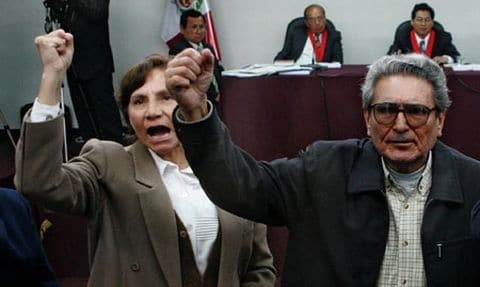Twenty years after the capture of Shining Path founder Abimael Guzman, some in Peru are concerned that the guerrilla group may be on the verge of a political resurgence.
On the night of September 12, 1992, an elite police squadron raided a home in the middle-class Lima neighborhood of Surco, capturing Abimael Guzman, the ideological and political head of the Shining Path guerrilla group. “My turn to lose,” the Maoist leader reportedly said to police as he was handcuffed and taken into custody.
But while the guerrilla army started by Guzman never regained the influence and control of territory that it had at its peak in 1990, there are signs that the Shining Path could be seeing a political comeback. As Reuters reports, many Peruvian analysts are worried about the rise of a political movement dedicated to securing the release of Guzman and other first-generation Shining Path leaders, known as the Movement for Amnesty and Fundamental Rights (Movadef).
Much of this alarm has had to do with the group’s alleged infiltration of the national teachers’ union, Sutep. Movadef has been accused of forming a faction of Sutep known as Conare, which began a strike in July. Sutep president Rene Ramirez told Reuters that he believes the sole purpose of Conare is to take control of the union and organize a radical turn to the left.
On a larger scale, there is also concern among Peru analysts that dissatisfaction with the policies of President Ollanta Humala, a former revolutionary leftist who has moved sharply to the center since coming to power, might drive more Peruvians towards Movadef. According to the news agency, Peruvian military intelligence sources believe that Movadef and other leftist groups in the country are stepping up political work with one plan in mind: “vacating the presidency through a coup by the masses.”
InSight Crime Analysis
Concern over the political infiltration of the Shining Path and related groups has been growing in Peru, and the government has taken steps to address it. In recent months the Humala administration blocked Movadef from registering as a political party and introduced a bill which would make it illegal to voice support for terrorism.
However, there is evidence to suggest that such measures are unnecessary. While Movadef may have received funding from the Shining Path faction headed by alias “Comrade Artemio” (who was captured in February, leaving the unit most likely defunct), it is not thought to have ties to the guerrilla column which remains, based in the Apurimac and Ene River Valley (VRAE).
In fact, the VRAE Shining Path has very vocally split with Guzman, and Movadef by extension. The group, headed by Victor Quispe Palomino, alias “Comrade Jose,” has rejected Guzman as a revisionist and a coward, and cast itself as the only legitimate revolutionary force in the country. Guzman has similarly distanced himself from the group, dismissing them in a 2009 interview with La Republica as mere “mercenaries,” citing their involvement in drug trafficking.
It is true that the 500-strong VRAE Shining Path still represents a military threat to the Peruvian government, as a series of successful guerrilla ambushes in the region illustrates. But even though the group has been attempting to deepen its political work in the VRAE, the scale of the threat cannot be compared to the Shining Path’s heyday under Guzman, when it had some 20,000 members and controlled swaths of the Andean highlands.

